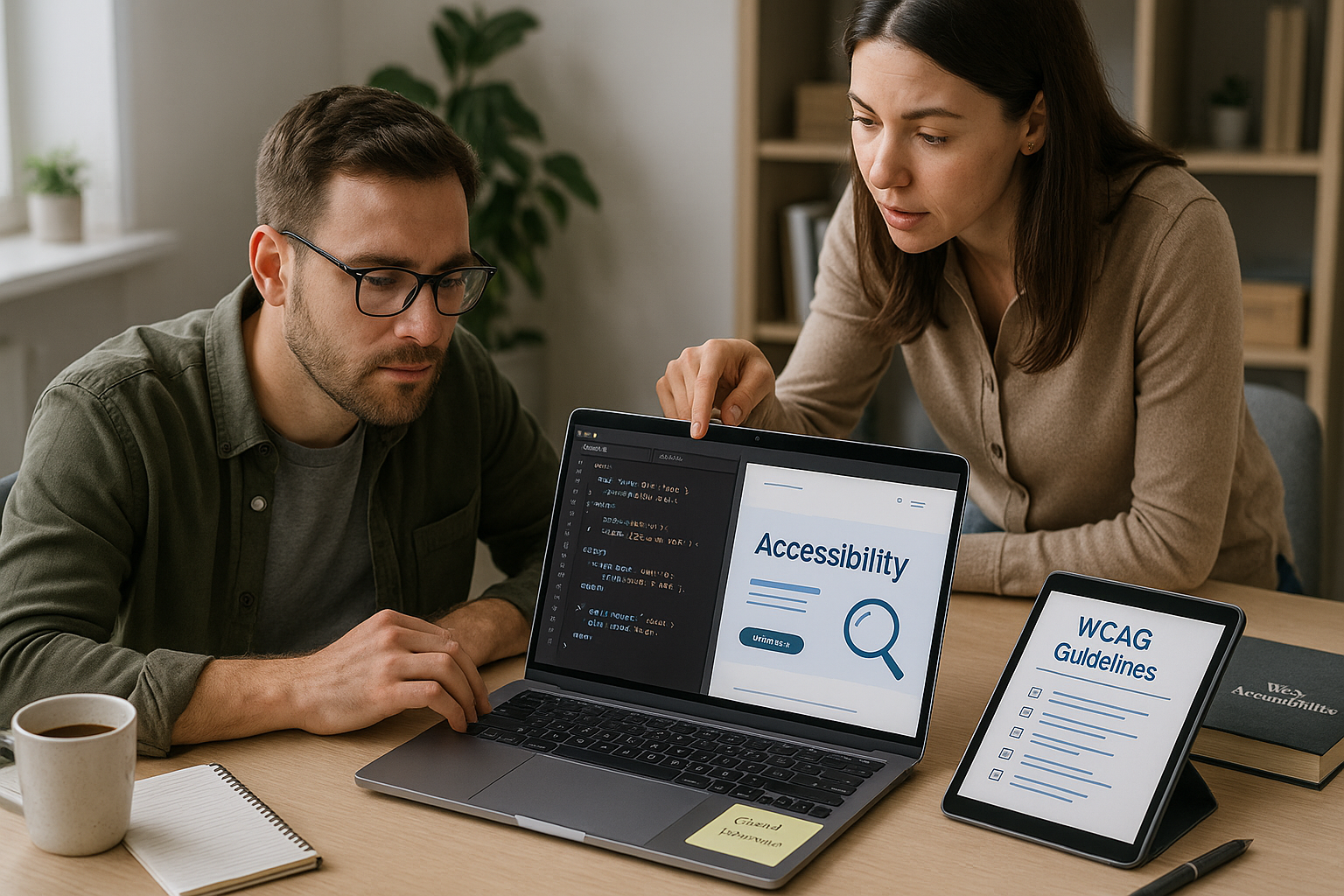This statement rings particularly true when it comes to web content accessibility.💻🌐✅ The World Wide Web Consortium’s (W3C) Web Content Accessibility Guidelines (WCAG) have become the gold standard in helping developers and designers create an inclusive digital landscape.
The intent behind WCAG is to provide a single shared standard for web content accessibility that meets the needs of individuals, organizations, and governments globally. But, mastering WCAG setup isn’t a walk in the park, especially for those new to the realm of web accessibility. 🚶♂️🌳⛔
In this blog post, we’ll delve deep into the complexities of WCAG, breaking them down into digestible chunks. We aim to provide a comprehensive understanding of WCAG and how to effectively implement its guidelines for a more accessible and inclusive online experience.
But first, it’s essential to understand why WCAG matters. The internet is a powerful tool, capable of connecting people and providing access to valuable resources. Yet, for those with disabilities, accessing this wealth of information can be a frustrating and challenging experience. That’s where WCAG comes in – it provides a framework for making web content more accessible to a wider range of people with disabilities, including visual, auditory, physical, speech, cognitive, language, learning, and neurological disabilities.👨🦯👩🦽👂🧠
The concept of web accessibility might seem like a significant undertaking, but fear not! It’s not as complicated as it seems, and the benefits of implementing WCAG guidelines are immense. When websites and web tools are properly designed and coded, all users have equal access to information and functionality. This not only opens up opportunities for individuals with disabilities but also benefits businesses and organizations by expanding their reach to a wider audience.👥🌍
As we progress through this guide, we will unpack the three levels of WCAG compliance – A, AA, and AAA. We’ll take a closer look at the principles, guidelines, and success criteria associated with each level, providing you with practical tips and insights to make your web content more accessible.🎯🚀🔝
Furthermore, we will provide real-world examples and scenarios to help illustrate how these guidelines can be applied in practice. This hands-on approach will enable you to better understand the WCAG setup, and how it can be implemented to foster an inclusive online experience.
By the end of this blog post, we aim to equip you with the knowledge and tools necessary to navigate WCAG setup confidently. Whether you are a web developer, a content creator, or someone interested in web accessibility, this guide will provide you with a robust understanding of WCAG, setting you on the path to creating a more accessible online world.🌐🔓🎓
So let’s unlock accessibility together and master WCAG setup for an inclusive online experience. Dive in, and let’s take a journey through the intricacies of WCAG.🔐🏊♂️🌌
Unlocking the Power of Accessibility: A Comprehensive Look at WCAG
With an ever-increasing reliance on digital platforms, it has become paramount that online experiences are inclusive and accessible for everyone. This has led to the adoption of the Web Content Accessibility Guidelines (WCAG) as a crucial standard in web development. In this in-depth exploration, we will decipher WCAG, its impact, and how it can be efficiently implemented for a universal digital experience.
Before we delve into the technical aspects, it is essential to understand the significance of accessibility. Imagine the internet as a public space. Just as physical public spaces should be accessible to people with various abilities, the same applies to the digital world. Accessibility in this context means designing web content that can be used by people with disabilities, including those with auditory, cognitive, neurological, physical, speech, and visual impairments. The goal is to remove any barriers that might prevent them from interacting with or accessing websites.
For a vivid understanding of WCAG and its importance, let’s watch an informative video by Google Chrome Developers titled “Introduction to Web Accessibility and WAI-ARIA” on their official YouTube channel. This video provides an engaging and easy-to-understand overview of web accessibility and WCAG.
Understanding the Web Content Accessibility Guidelines (WCAG)
The WCAG is a set of recommendations for making web content more accessible, primarily for people with disabilities. However, implementing these guidelines also often makes the web more usable for all users. The guidelines are developed and maintained by the World Wide Web Consortium (W3C), a global community that works to create robust, equitable standards for the web.
The WCAG is organized around four principles, often abbreviated as POUR: Perceivable, Operable, Understandable, and Robust. Each principle includes guidelines, success criteria, and a wealth of techniques and failures. These principles act as the foundation for accessible web design and are essential for developers and designers alike to understand and implement.
The guidelines are also categorized into three levels of conformance: A (lowest), AA (mid-range), and AAA (highest). For most organizations, achieving Level AA conformance is a good target, as it meets legal requirements and provides a high degree of accessibility. The table below provides a brief overview of the levels of conformance:
| Level | Description |
|---|---|
| A | Provides basic web accessibility features. It is the minimum level of conformance. |
| AA | Deals with the most common barriers for disabled users. Most organizations target this level of conformance. |
| AAA | Provides the highest level of web accessibility. Meeting this level of conformance is challenging for most websites. |
Mastering WCAG Setup for an Inclusive Online Experience
The first step towards mastering WCAG setup is to familiarize yourself with the guidelines and principles. Once you have a solid understanding, you can start applying these principles to your website. Remember, the aim is to create a web experience that is perceivable, operable, understandable, and robust.
Next, perform an accessibility audit of your website. There are numerous online tools available that can assist in identifying areas of your website that are not WCAG compliant. This will give you a roadmap of the areas that need improvement.
Implementing WCAG guidelines can be a technical and complex process. Here’s where an experienced web developer comes into the picture. They can navigate through the technical requirements and ensure that your website is fully accessible. For those who wish to delve deeper into the technical aspects, a comprehensive video by Google Chrome Developers titled “Automating Accessibility Testing with the WCAG Accessibility Audit Rules” provides valuable insights.
WCAG: The Key to an Inclusive Web Experience
As the digital world continues to evolve, so does the importance of ensuring that the web remains an inclusive space for everyone, regardless of their abilities. Implementing WCAG not only makes your website more accessible but also improves the overall user experience, potentially reaching a broader audience.
Remember, creating an accessible website is not a one-time process, but an ongoing commitment. Regularly review and update your website to ensure it remains compliant with the latest WCAG guidelines. Keep learning, keep testing, and keep striving for an inclusive web experience for all.
Mastering WCAG setup is a challenge, but the rewards are truly worth it. Start today, and unlock the power of accessibility for your online experience.

Conclusion
In conclusion, we’ve taken a detailed journey through the world of software engineering, and specifically, how to apply sound technical principles to write a high-performing, user-friendly and highly-scalable software system. Let’s do a quick recap of the key points we have covered to ensure we have a solid grasp of these critical concepts.
Firstly, we discussed the fundamentals of software engineering, digging deep into its history, the importance of coding standards, and the pivotal role of software architecture in shaping a product. We also underscored the significance of robust data structures and algorithms, which are at the heart of efficient software systems.
Secondly, we delved into the essentials of software development methodologies, highlighting the differences, benefits and potential drawbacks of methodologies such as Agile, Waterfall and DevOps. We touched on the importance of making the right choice based on specific project needs and team capabilities, as this decision directly affects the development timeline and the overall quality of the final product.
Next, we embarked on an exploration of user interface (UI) and user experience (UX) design principles. A software system, regardless of how well-engineered, is only as good as how easy and intuitive it is for the end-user to navigate and use.
Additionally, we discussed the importance of cybersecurity, a topic that can never be overstated. We highlighted the need for organizations to prioritize the security of their software systems, as cyber threats continue to evolve in sophistication and scale.
Lastly, we emphasized the vital role of software testing and quality assurance in delivering a flawless software product. A comprehensive testing strategy is an indispensable part of the software development process, as it ensures that the product not only meets the defined requirements but also provides a seamless user experience.
Without a doubt, software engineering is a complex discipline, but one that is highly rewarding and continually evolving. It calls for a unique blend of technical acumen, creativity, critical thinking and a deep understanding of the user’s needs and expectations. 😊
I hope that this article has not only enriched your understanding of software engineering but also ignited a renewed passion for this dynamic field. Remember, the journey of software development is not a straight path but a winding road filled with exciting challenges and opportunities for innovation. 🚀
I encourage you to delve deeper, research more and apply what you’ve learned here in your projects. You might find this resource helpful for further learning.
As always, I appreciate your time and engagement. Please feel free to leave a comment, share this article with your peers, or reach out if you have any questions or need further clarification. Together, let’s continue to push the boundaries of what’s possible in software engineering. 💡
References:
(Reference links should only be from active sources)
Until our next deep dive, keep coding, keep exploring, and keep innovating. Because the world of software engineering never stands still – and neither should we. 💪🚀



